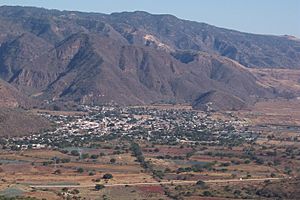Jala, Nayarit facts for kids
Jala is a town and a municipality in the Mexican state of Nayarit. In 2005, about 16,071 people lived in the municipality. The town of Jala itself had a population of 9,631. It covers an area of about 364.60 square kilometers.
Contents
What Jala's Name Means
The name Jala comes from the Nahuatl language. It means "place where there is a lot of sand." The word xali means sand, and tla means a place with plenty of something.
Where Jala Is Located
Jala is located in the southern part of Nayarit, Mexico. It sits between certain latitude and longitude lines. To the north, it shares borders with Santa María del Oro and La Yesca. To the south, it borders Ahuacatlán and Ixtlán del Río. Ixtlán del Río is also to its east, and Santa María del Oro is to its west. The Rio Grande de Santiago, a large river, flows north of the municipality.
Jala's Economy and Jobs
The economy in Jala is mostly based on farming. Farmers grow important crops like corn, sorghum, peanuts, sugarcane, and different kinds of fruit. People also raise cattle and pigs.
There are also some factories and businesses in Jala. These include places that process sugarcane, sawmills, and brick factories. You can also find furniture factories, a packing plant for peaches, and other small businesses that make things.
Fun Places to Visit in Jala
Jala has some interesting places for visitors to explore.
Ceboruco Volcano: A Natural Wonder
One of the main attractions is the Ceboruco volcano. You can reach it by driving about 18 kilometers on a stone road from the main highway. From the end of the road, it's a 3-kilometer walk up a path to reach the volcano's crater.
Ceboruco last erupted between 1870 and 1872. This eruption created a large flow of lava. Scientists believe that in ancient times, Ceboruco had at least two very big eruptions. These eruptions formed two large, round hollows called calderas. Ceboruco rises about 1,000 meters above the land around it. Its highest point is about 2,164 meters tall. The original volcano was made mostly of thin lava flows and layers of ash. After the calderas formed, the lava flows became much thicker.
Ancient History: The Archaeological Site
Near Jala, there is also an archaeological site. This is a place where scientists dig up old buildings and artifacts. Here, they found a temple and burial grounds that are thought to be from around 700 AD. This site is special because it has one of the few pyramids in Mexico that has a round base. Another famous round-based pyramid is found near the town of Tequila, called Guachimontones.
See also
 In Spanish: Municipio de Jala para niños
In Spanish: Municipio de Jala para niños


